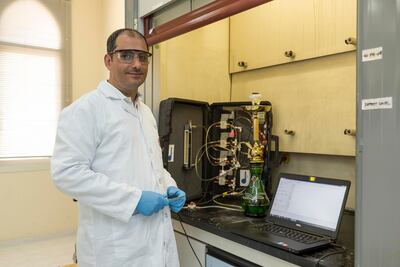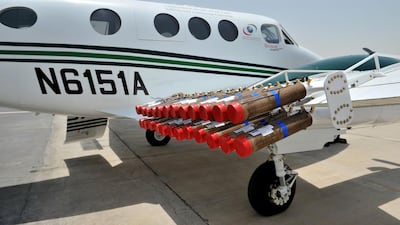Cloud seeding is helping to clear the air in the UAE, according to researchers who analysed pollution levels in Abu Dhabi and Dubai.
In a recent study, scientists wrote that natural dust storms are a source of the particulate matter in the air.
They also found that dust contained heavy metals, such as lead, at concentrations that could be harmful, and highlighted the likelihood that human activity causes such contamination.
The outcome of their two-year study into atmospheric dust and sand in the UAE were released in the journal Environmental Pollution.
Lead author Dr Yehya Elsayed, of the Department of Biology, Chemistry and Environmental Sciences at the American University of Sharjah, said the government provided “generous annual funding” for cloud seeding in recent years, which may have improved air quality.

“As a result, the UAE has witnessed rainfall from cloud seeing projects that caused precipitation of the suspended particulates and a drop in dust and total suspended particulates levels,” he said.
“This enhanced the visibility, as witnessed during winter seasons.”
Cloud seeding in the UAE dates back more than two decades and is now undertaken regularly and the National Centre of Meteorology said in July that 219 operations took place in the first six months of 2020. Flares, carried up by aircraft, release salt particles around which water droplets condense and fall as rain.
Cloud seeding is used to promote rain and replenish the UAE’s groundwater reserves, rather than to reduce pollution.
With most parts of the country receiving less than 100 millimetres of rain a year, water extraction for agriculture, industry and domestic use is said to deplete reserves by 5mm per year.
In their recent paper, Dr Elsayed and his co-authors, including his AUS colleague Dr Sofian Kanan, recorded particulate matter concentrations at sites near Abu Dhabi and Dubai airports in 2016 and 2017 and found levels peaked between June and August.
Concentrations of PM with a diameter of up to 2.5 micrometres (PM2.5), which are considered dangerous, were typically between 50 and 100 micrograms per cubic metre (µg/m3), but during mild storms could reach 350 to 400 µg/m3. The US Environmental Protection Agency recommends average PM2.5 levels should not exceed 12 µg/m3.
Particulate matter up to 10 micrometres (PM10) was recorded at concentration between 100 to 250 µg/m3 on most days, but during storms could reach 750 µg/m3. The EPA recommends levels should not exceed 150 µg/m3 more than once a year.
Dust was found to be contaminated with heavy metals such as lead, contamination the authors said poses “a health risk given the dust exposure is continuous during summer seasons”. Lung cancer and cardiovascular disease are among the serious health conditions the scientists said the particles could cause.
“The presence of toxic metals in these fine particles may have dual destructive effect on human health associated with particle size and toxicity of the inhaled toxic metals,” Dr Elsayed said.
They also said metals in the dust may harm aircraft, citing previous studies indicating they caused deposits inside jet engines and could block holes for cooling and lead to corrosion. But they forecast pollution levels would fall.
“We expect further reduction in the human contribution to pollution, especially with the shifting to nuclear power plants and electric cars, stricter regulations on car and industrial emissions, and advanced engine designs and cleaner fuel specifications,” Dr Kanan said.
Overall levels of particulate matter fluctuate from year to year, with the researchers finding that 2017 had less than 2016.
But separate research published in November by Dr Abdelgadir Abuelgasim, of UAE University in Al Ain, and Dr Ashraf Farahat, of King Fahd University of Petroleum and Minerals in Saudi Arabia, found that pollution levels went up between 2017 and 2018, probably because the number of storms increased.
The size of particles indicated that within Abu Dhabi emirate, air pollution was “primarily driven by natural processes related to local and cross-boundary dust storms” rather than human activity. But they also blamed “excessive use of domestic cooling” for releasing PM.
When analysing Environment Agency Abu Dhabi data recorded at monitoring stations across Abu Dhabi emirate, they found elevated PM levels in July and August, tying in with the AUS study.
"PM levels began to decrease by late September and usually reach their lowest levels by December," the scientists wrote in Earth Systems and Environment.


